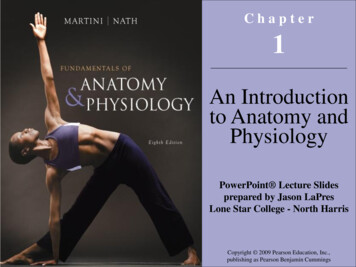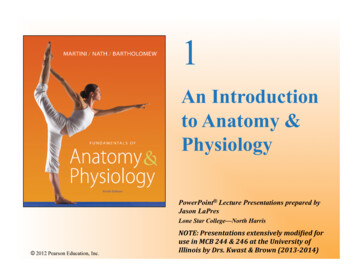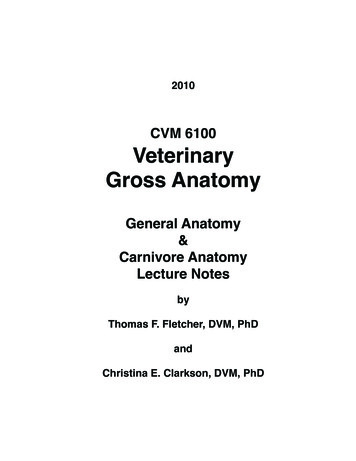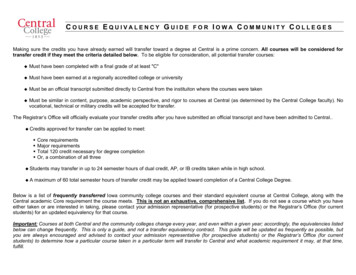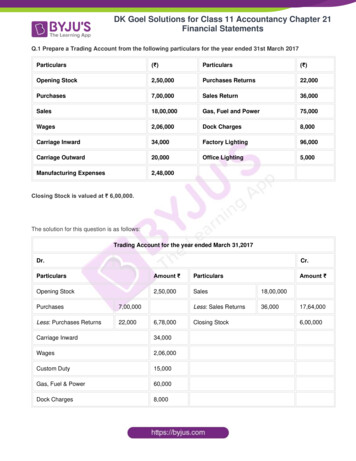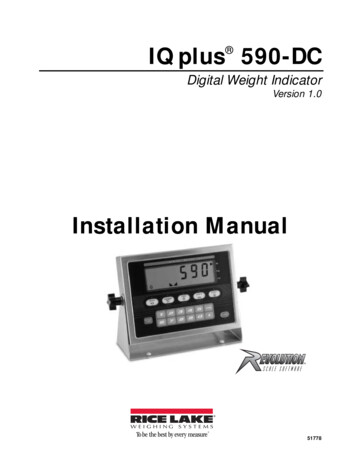
Transcription
Journal of Learning and Teaching in Digital Age, 2021, 6(2), 90-96https://dergipark.org.tr/en/pub/joltidaISSN: 2458-8350 (online)Research PaperGross Anatomy during COVID-19: The Effectiveness of Utilizing a 3-D AnatomyApplication among Occupational Therapy Students in a Pandemic-induced OnlineCourseMartin G. Rosario*aa(ORCID ID: 0000-0001-7505-1329), Texas Woman's University, Dallas, TX, USA, mrosario1@twu.edu*CorrespondingauthorARTICLE INFOABSTRACTReceived: 05 October 2020Revised: 19 January 2021Accepted: 19 January 2021As a result of the current COVID-19 pandemic, converting traditional face-to-face instructionalmethods into online courses have been a challenge. Online teaching offers limited options and meansfor explaining human anatomy, inflicting significant hardships in perceiving the depth andorganization of anatomy among graduate students. This article addresses the integration of a 3-Danatomy application into an online graduate anatomy course among ninety-five Occupational Therapyscholars with various academic backgrounds enrolled via an online survey. Complete 3-D Anatomyapp was used as a reinforcement to teaching human anatomy within the format of online Zoomsessions. Students’ test scores and survey responses were employed to gather the informationpresented in this review. Results showed that all scholars believed the anatomy app was a usefulsupplement to the understanding of human anatomy, while the app-user pupils earned a greaterpercentage of passing grades in comparison to their peers in the non-app user group. Adopting the 3D anatomy app as a supplemental tool during online anatomy courses to enhance students’understanding of human anatomy was successful. For prospective anatomy courses, we plan tointegrate and explore the influences of an individual tablet/iPad with 3-D apps for each student fordistinct insights on the impact of maneuvering and examining anatomical structures.Keywords:3-D Anatomy AppOnline Teaching ToolsHuman AnatomyCOVID-19 TeachingTeaching ToolINTRODUCTIONTeaching and understanding the human body has its demands (Houser & Kondrashov, 2018) and as of late, the conventionalapproach to schooling and implementing content for anatomy courses have been challenged due to new circumstances (Brassett etal., 2020). For anatomy professors and courses around the world, the prevailing COVID-19 pandemic (Wang et al., 2019) forcedadaptations from face-to-face delivery to an online set up over a limited period of time (Brassett et al., 2020), further addinguncharted demands to the hardship of both teaching and comprehensively understanding 3-dimensional anatomy.Historically, content of courses related to gross anatomy are often conveyed with textbooks (Hammond, I., et al., 2003), and in moreadvanced programs, cadaver dissections and prosections (Houser & Kondrashov, 2018). One constraint of teaching andunderstanding anatomy with 2-dimensional tools, such as books, is the failure to communicate and recognize the depth perceptionand positioning of distinct anatomical arrangements. The capability to manipulate structures and adequately discern the relationshipbetween diverse levels, especially for smaller structures like neuromuscular vessels, is restricted in traditional 2-dimensionalanatomy learning (Berkowitz et al., 2014).Typically, to promote thorough instruction-learning processes of gross anatomy, institutions with advanced clinical programs relyon the gold standard technique of cadaver dissection and prosection. To supplement cadaver dissection, there are multiple tools andapproaches to ease the understanding of depth perception and the relationship of deeper and more diverse arrangements within thehuman body, with many of these accessories or teaching techniques focusing on anatomical models, virtual dissection tables, andvirtual reality (Iwanaga, 2020). There are additional adjust tools to cadaver dissection to enhance the teaching-learning experience,such as augmented reality (AR), the use of 3-D apps (Uruthiralingam & Rea, 2020) and virtual dissection tables (Bork, 2019), allof which have numerous advantages.Augmented reality is a valuable supplement for the direction and grasp of human anatomy. AR systems have been shown to besuccessfully integrated into anatomy courses and are comparable to traditional learning tools for programs with diverse backgroundsor specialties (Bork, 2019; Duncan-Vaidya & Stevenson, 2020).Other capable instruments that enhance 3-D perspectives, aid with depth perception, allow for the maneuvering of structures, andoverall comprehension of anatomy are virtual dissection tables (VDT) such as the Anatomage (https://www.anatomage.com). TheVDT is advantageous for manipulating and recognizing the relation and integration of anatomical arrangements (Brucoli et al.,2020), as well as meticulously illustrating the details of human anatomy (Rosario et al., 2019). VDT are suitable mechanisms for 2021, Journal of Learning and Teaching in Digital Age, 6(2), 90-96
M. G. Rosariosupporting the understanding of anatomy and the association between distinct anatomical patterns, while providing the unique theability to manipulate and navigate through diverse anatomical structural strata (Brucoli, 2019, & Ward, 2018).Both tools cited above require an interactive face-to-face format to teach and learn anatomy; the VDT is a substantially sized pieceof equipment designed to emulate a full-scale human cadaver, and AR is a goggle type gear that requires placing the device on theusers’ head and face. Unfortunately, due to recent events resulting from the COVID-19 pandemic, a shift from face-to-face to onlineconfiguration was mandatory, making the incorporation of both AR and VDT in anatomy courses unfeasible.One substitute for enhancing learning and instruction in anatomy during the prevailing online situation is 3-Dimensional virtualanatomy apps, which are as detailed and valuable as other supplementary devices employed to strengthen the comprehension ofanatomy (Iwanaga J. 2020). The 3-D anatomy app tool has been verified to be innovative and a preference among learners whileadvancing the knowledge of anatomy in the classroom (Chakraborty & Cooperstein, 2018; Houser & Kondrashov, 2018; RosarioMG et al., 2019). Research indicates that many specialized and advanced programs have adopted the practice of utilizing 3-Dapplications with dual success by both targeting the student's perceived benefits and reinforcing the comprehension of anatomyamong participants (Bairamian, Liu, & Eftekhar, 2019; Ha & Choi, 2019).It is essential to note that there are no substitutes for physical cadaver dissections, and to reiterate, 3-D apps are a supplement tocadaver dissection and understanding human anatomy. However, as previously mentioned, the obligation for the ongoing movementfrom hands-on cadaver dissection to the online 2-dimensional configuration has been the norm, lately. For that reason, 3-Dapplications are proving to be favorable, especially when face-to-face is not a viable option (Uruthiralingam & Rea, 2020). Whileonline instructional formats do have the advantage of allowing for social distancing, it is a 2-dimensional surface that does notfacilitate depth perception, anatomical associations, or clinical applications. By integrating 3-D anatomy tools into online lecturesand laboratories, this issue can be alleviated by developing a customized understanding during both components of the course.As previously stated, comprehensively learning human anatomy is difficult for students, even with cadaver dissection, making thisnew direction of online education, teaching, and learning anatomy even more difficult. One solution to ease this difficulty is byemploying 3-D anatomy applications for a further, more in-depth understanding of anatomy as an extension to anatomy courses indifferent programs. Therefore, considering the above mentioned, this inquiry aims to explore and report the advantages of integratinga 3-D anatomy application into an online anatomy course for occupational therapy students. Today's education model, developed tomeet the needs emerging with the industrial revolution, has changed with changing conditions over time. There is a change fromtime-based student development to proficiency-based student development, norm-based tests to criteria-based tests, passive andteacher-directed students to active and self-supervised students and more (Reigeluth & Karnopp, 2013). This change in educationhas created new situations such as individualized learning, determining student behaviors and using alternative assessment tools(Lee, Huh, Lin, & Reigeluth, 2018).METHODSParticipantsNinety-five students enrolled in the Doctor Program in Occupational Therapy (one male and ninety-four females) taking grossanatomy in an online format partook in this inquiry by completing the online survey.EquipmentFor this examination, a 3-dimensional application ("Complete Anatomy" app on an Apple iPad Pro) was employed as a complementto the anatomy course in an effort to emphasize upon various areas and topics of individual anatomical arrangements. Since thecourse configuration was online, we used the Zoom platform for virtual sessions for all the lectures and labs (https://zoom.us/). The3-D anatomy app was then implemented to demonstrate the anatomical concept of the assigned area. Examples of topics the appcovered included, but was not limited to, muscle function-action, proximal and distal attachment, skeletal landmarks, along withassociated neuromuscular structures.The lecture and laboratory components were prepared to show the applicable anatomical region through PowerPoint presentationsthat were further highlighted by the 3-D viewpoint. The 3-D allocation of the class was then open for discussion through queriesfrom the anatomy instructor.SurveyAt the concluding stage of the anatomy course, the students were given the option to provide feedback, along with their opinionsand beliefs regarding the supplemental teaching strategy of incorporating the 3-D app. The questions were tailored to examine thestudent's perception of integrating the app into the course via a Likert scale (Albaum, G. 1997) and their preference for the differenttools presented during the course. Additionally, pupils were asked if they obtained a 3-D anatomy app and the timeline of whenthey purchased the app (beginning of the semester compared to mid-semester).91 2021, Journal of Learning and Teaching in Digital Age, 6(2), 90-96
Anatomy 3-D app during COVID online TeachingMidterm and Final TestsAs per course requirements, all students took part in a midterm and a final exam worth 100 points each. The material handled in themidterm was related to the back, upper extremity, and lower extremity regions, whereas the content of the final exam included thethoracic, abdominal, and pelvic cavities, as well as the head and neck regions.DATA ANALYSISThe questionnaire was conducted through Socrative, an online quiz/test program (Socrative, 2019). The information collected fromthe completed surveys were then placed into an Excel spreadsheet, where descriptive statistics, averages, and percents were analyzedby SPSS version 25.The benefits of using the 3-D anatomy app were evaluated by comparing 3-D app users to non-users. Accordingly, the partakerswere divided into two groups: the app users group (AUG) and the non-app user group (NAUG). All students in the anatomy coursewere encouraged to purchase the 3-D app at the start of the semester, however, only 66% percent (as seen in Appendix 4) obtained3-D apps, thus allowing for the allocation of participants to the AUG and NAUG groups. A one-way ANOVA was conducted tocontrast both groups and a p-value of 0.05 was considered to be significant for the purposes of this investigation.RESULTSThe number of participants and their academic backgrounds are depicted in Table 1; the majority of participants were female and,given the requirements for admission into the occupational therapy program, they had similar levels of academic degrees.Table 1. Participants gender and academic backgroundCharacteristicsStudy Participants n 95GenderMale 1; Female 94Academic BackgroundBiology, Kinesiology or Movement related: 71.9 /-9.6Other (Psychology): 67.3 /- 12.9In order to thoroughly understand the effectiveness of the 3-D application, this study compared the average course score of AUGversus NAUG. As seen in Table 2, those in the AUG had better average scores in the course than those in the NAUG, however, thedifference was not significant.Table 2. Comparison among 3-D app user and non-userCharacteristicsParticipants n 35App Non-UserParticipants n 60App userP valueCourse Grade79.3 /- 12.381.7 /- 8.50.25**Anova analysis was performed with a P value of 0.05 as significant.We recognize that the most impactful point of the semester to ascertain the benefits of the 3-D app and the acquisition of anatomicalknowledge is at mid-semester, where other factors like mental fatigue and mental exhaustion among other psychosocial determinants(Szemik et al., 2020) had less influence on test scores. Therefore, a grade ( 70% pass, 70% fail) comparison was then used toascertain the percentage of app users in each category. A significant percentage of the scholars that passed the midterm utilized the3-D app in comparison to those that earned failed, as illustrated in Table 3. An essential factor that could influence scores is theiracademic background. Therefore, in this study, we assigned students with majors that include anatomy courses or sciencesmovements in one group, and those with majors in other sciences, such as psychology or music, in the other. More students withanatomy or science movement backgrounds earned a better score in comparison to those with other types of academic backgrounds,as illustrated in Table 4.Table 3. Grades comparisons related to academic backgroundCharacteristicsParticipants n 47Biology, Kinesiology orMovement related:Participants n 45Other (Psychology):P valueCourse Grade81.5 /-10.078.9 /- 10.20.54**Anova analysis was performed with a P value of 0.05 as significant.92 2021, Journal of Learning and Teaching in Digital Age, 6(2), 90-96
M. G. RosarioTable 4. Comparisons of grades related to passed or failedCharacteristicsParticipants n 14FailedParticipants n 76PassedP valueMidterm Grade51.3 /-8.975.6 /- 9.3*0.01App User0.43 /-0.50.66 /-0.50.11*Anova analysis was performed with a P value of 0.05 as significant.Most of the pupils deemed the 3-D anatomy app as a valuable tool during the online anatomy course, as well as a helpful tool in thecomprehending human anatomy. Additionally, a considerable number of students preferred the 3-D app over the atlas during theirown anatomy review. However, when it came to acquiring the 3-D app, only 66% of students that completed the survey obtainedthe app after the semester started. The overall results of the survey can be seen in Table 5.Table 5. Students’ response to survey and percentageQuestion1. In a scale of 1-5 (1 not helpful, 5 veryhelpful) did the ipad-anatomy app help youunderstand some of the anatomy from this laband course?2. From the teaching tools required in thecourse, please choose the one you liked more:3. Do you prefer the 3D anatomy app or atlas?4. Do you believe the 3D anatomy app washelpful for you in the course?5. Did the use of the 3-D app in class helpedyou understand some concepts better?6. Did you purchase a 3D anatomy app for thiscourse?7. If you purchased a 3D anatomy app, when?OptionsResponses1. Very helpful26/95Percentage%27%2. Helpful3. Good4. Somewhat helpful5. Not HelpfulA. Ipad-Anatomy AppB. BookC. Anatomical ModelsD. AtlasA. 3D 17%11%3%60%13%12%16%76%B. AtlasA. YesB. NoA. YesB. NoA. YesB. NoA. Start of courseB. Mid 99%1%99%1%63%37%27%38%DISCUSSIONThis aspiration of performing this inquiry was to explore the benefits of incorporating a 3-Dimensional anatomy application into anonline anatomy course for occupational therapy students. Due to recent pandemic restrictions, many of the curriculums wererequired to shift to an online format. Founded upon the students’ feedback and examination results, the supplementation of the 3-Danatomy perspective to the lecture and laboratory was proven to be successful.Students often experience difficulties in understanding the relationships present among the various structures and depth perceptionfrom one-dimensional projections and study aids, such as textbooks and atlases. Resulting from the requirements for socialdistancing (Wang C, et al., 2019) and having to teach online, 2-dimensional presentations, such as powerpoints, are the standardgiven that other common methods, such as cadaver dissections, cadaver prosections, augmented reality, and virtual dissection tablesare not feasible to incorporate. In an attempt to help students promptly discern the anatomical concepts, this report focused on theimpact of adding a 3-D anatomical application perspective to the anatomy course, which revealed several discoveries that are worthsharing.The first finding from this study revealed the preferred and perceived benefits for most students when utilizing the 3-D app in thegiven lecture and lab, as depicted in Appendix 5. Numerous pupils chose the app over books, models, and atlases, as they found theapp helpful in their overall comprehension of human anatomy (Appendix 5). This report illustrates the usefulness of adding in the3-D anatomy application to applicable online lecture and lab settings. These results follow other studies which have investigated93 2021, Journal of Learning and Teaching in Digital Age, 6(2), 90-96
Anatomy 3-D app during COVID online Teachingthe effectiveness of a 3-D anatomy app as an adjunct to established, in-person teaching methods (Ha, JE &Choi, DY., 2019). Thus,based upon the findings above, we recommend adding the 3-D app to anatomy related courses.One limitation of collecting data regarding the perceived benefits of the 3-D app from the survey was the inability to assess allstudents' performance and understanding of different anatomical concepts. Therefore, to better discern the impact of adding the 3D application to the course, as well as the scholars’ comprehension of human anatomy, the current study analyzed the said cohorts’test scores. It is worth mentioning that the average score for the midterm exam was 76%, and 76 out of 95 students passed themidterm test, as seen in Appendix 4. From this, we can speculate that the 3-D app could be an influencing factor that aided in thecomprehension of anatomy and, therefore, a passing grade. However, another limitation of the present study is having only onecohort participating in the online anatomy course; with this, we recognized that other factors could have attributed to the passinggrades, such as students’ academic backgrounds (Appendix 3). Taking the aforementioned into consideration, along with thelimitation of not having a control group prior to the pandemic to provide a baseline comparison, this study focused on the effect ofbeing a 3-D app user in comparison to those who are non-users.As seen in Appendix 2, numerous students purchased the app as per the course instructor’s recommendation, however, sinceacquiring the 3-D app was discretionary, several students chose to not obtain the application, thus creating the opportunity tocompare app users to non-app users for the purpose of this examination. With this in consideration, the other outcome of thisinvestigation was related to the differences in test scores of the AUG and NAUG; the majority of students that purchased the 3-Dapp performed satisfactorily with an average passing score for the examinations in comparison to the students that did not obtainthe 3-D app (Appendix 4). This suggests quantifiable and noticeable advantages to using and manipulating the 3-D app, translatingto an increase in the overall understanding of human anatomy. Various studies had similar approaches in using adjunct tools for anadequate comprehension of anatomy with success. An example of this is the report by Peterson and Mlynarczyk (2016), in whichthey explain the benefits of using the 3-D perspective as an adjunct for students' conception of complex anatomy regions built intothe anatomy curriculum. In their study, students that had the benefit of interacting with this 3-D tool performed better in tests andexhibited a long term understanding of anatomy (Peterson & Mlynarczyk, 2016). With this, we recommend adding time formastering the skill of working with tablets and other devices which run the 3-D app within the curriculum, a consideration whichwas also suggested by Chakraborty and Cooperstein (2018). We propose the promotion of 3-D applications as a requirement foranatomy related courses, especially under circumstances where cadaver dissection and prosection poses a challenge. We also suggestusing the 3-D app in every anatomy lecture and lab to allow students to become adequately acquainted with the device and 3-D appfor a more efficiency in the use of the tool and, ultimately, a better understanding of detailed human anatomy.Some students desire to exclusively use the tools which they are familiar with, as reported by the small percentage of learners thatprefer books over the 3-D app (Appendix 5). Specialized anatomy atlases are reported to be beneficial in reviewing andunderstanding anatomy, with many courses having them as a requirement alongside the assigned textbooks and proposed references.The standard of mainly every course falls back to the utilization of books and other forms of text, making these tools common andfamiliar to students. This study ventures to add a 3-D application instrument to the current blend of tools used in anatomy courses,yet does not intend to substitute any standard or previously-established methods.As mentioned, books and screens are 2-dimensional structures that limit the adequate comprehension of depth perception andlocation of anatomical structures. Perhaps, rather than substituting books for an app, instructors should incorporate activities intotheir anatomy courses that allow for the book and 3-D app to work concurrently. It is our belief that in doing so, these activities willeducate students to use both their books/atlases and a 3-D app simultaneously to bridge the gap between the concept of theapplication and the actual comprehension of the content taught in anatomy courses.After the inclusion of the 3-D app within the lecture and lab, an indisputable growth in interest and urge to learn human anatomyarose; this behavior can be associated with providing students with a multidimensional view and perspective of the anatomicalstructures (Berkowitz et al., 2014). Some examples of students’ feedback were:"It helps you understand location, function, and relationships of organs in the body. It was especially helpful when studying themuscles because I could see the location and action of the specific muscle.""With the 3D anatomy app, I like how we can physically see each muscle, bone, nerve, etc. and where they attach onto the body.Although pictures are helpful, more often than not, a piece of an organ or a muscle is missing as it is hidden behind anotherstructure. The 3D model prevents this, and even with the screenshots of the 3D app placed in the PPTs, it is helpful for me to applythe knowledge to the real body.""I like how you (instructor) pulled up the app during lecture and used it "real-time" to show us the muscles you lectured on."These comments, coinciding with the outcomes of this report, were notably positive and encouraging for us to conclude that the useof 3-D anatomy apps is advantageous for occupational therapy students.Although the grades and feedback from many of the students were positive, several other pupils were unable to perceive the samebenefits from this approach in online teaching, as they exhibited a more passive demeanor. An example of students’ comments is:"The navigation is a bit difficult for me to figure out when I am doing it alone vs. being shown in class."94 2021, Journal of Learning and Teaching in Digital Age, 6(2), 90-96
M. G. RosarioWhen asked how we can improve the use of this 3-D anatomy tool, some student suggestions were:"I think applying it more in class would be helpful, such as in PowerPoint or taking time to utilize it rather than lecture. I also thinkusing those photos on tests, since they are more realistic, would be helpful.""Because we are doing everything virtually and don't have access to actual anatomical models, I thought the 3D app was used wellbut not frequently enough in class.""Perhaps having an allotted time in class to use the tool for everyone's viewing."Rather than using the app to further their own specific understanding of anatomy, they expected to have more time to view the appwithin the course as the instructor passively presented it. This type of perspective and mentality was also encountered by Petersonand Mlynarczyk (2016), when pupils reported not perceiving an added benefit to the addition of this 3-D technology.Students also appreciated and shared the impact of utilizing and manipulating the 3-D app throughout the course. Some of theremarks included, "Using the app yourself and not just seeing a slide of it makes the app more useful in learning," while otherspointed out the advantage of discussion when they mentioned aspects such as, "If students have the tool, they can ask you (Instructor)questions about the app based on their experiences." Taking the above into consideration, we recommend the addition of a 3-Dperspective into anatomy courses as a requirement, with the added advantage of embedding this tool within the lecture and lab timeto build assignments in which students are encouraged to interact with the app every day. We recommend adding activities wherestudents are in charge of demonstrating the anatomical topic or structure of the day to their peers using the 3-D perspective, ratherthan the professor doing so in order to implement a learn-by-teaching approach. Altogether, we firmly believe 3-D anatomyapplications will aid students in programs that require gross anatomy in better experiencing human anatomy in a timely andcomprehensive manner.CONCLUSIONAs previously mentioned, cadaver dissection is an exceptionally unreplaceable experience (Ghosh S.K. 2015). With the ongoingCOVID-19 pandemic (Wang et al., 2020 & Sohrabi et al., 2020) courses across various programs had to shift from the classroomsetting to an online format, inflicting new challenges to the teaching-learning environment. To aid in students’ comprehension ofthe course content while shortening the partition formed by the lecture and 2-D images during online teaching and minimizing thetime employed in binding notions within the lecture and the anatomy lab (Krause et al. 2015), the 3-D application discussedthroughout this paper is worth considering as supplemental human anatomy tool. Scholars in diverse scenarios and fields have alsoexamined the effects of utilizing approaches that include such technology, all of which have been deemed successful (Berkowits etal., 2014, Brucoli et al. 2018; Chakraborty & Cooperstein, 2018; Raney, 2014). As per the findings of this study, we suggest theintegration of 3-D anatomy apps into every anatomy related course, regardless of which program, degree, or major the students areenrolled in. Also, since graduates have a tendency to be passive, we advocate building time within the curriculum for learners tomanipulate the app and perform assigned activities. We further recognize that to help achieve depth perception, location, andorientation of gross anatomy over a shorter period of time, scholars must interact with their 3-D anatomy application individually,aside from passively observing the instructor demonstrating the tool to the scholars within teaching and lab scenarios. Overall, theintegration of 3-D anatomy apps as a supplemental tool into graduate anatomy courses alongside conventional teaching strategies(Alsharif et al. 2018; Lewis et al. 2014; Berkowitz et al. 2014) appear to heighten students’ thorough comprehension of humananatomy.Funding Statement: This work was not funded.Ethics and Consent: The author employed the ARECCI tool to specify and justify that this study is categorized under the ProgramQuality Improvement, for which the ARECCI tool is instructed instead of an Institutional Review Board. The outcomes can beaccessed at this URL: ents: The authors wish to thank all the scholars that completed the survey in which this work was based. Theydeclare no conflicts of interest.REFERENCESAlbaum, G. (1997). The Likert scale revisited. Market Research Society. Journal, 39(2), harif, W., Davis, M., Rainford, L., Cradock, A., & McGee, A. (2018). Validation of the educational effectiveness of a mobilelearning app to improve knowledge about MR image quality optimization and artefact reduction. Insights into Imaging,9(5), 721-730. https://doi.org/10.1007/s13244-018-0635-0Apple (2019). Apple iPad Pro. One Apple Park Way Cupertino, CA 95014. -5 [accessed 11 February 2019]Bairamian, D., Liu, S., & Eftekhar, B. (2019). Virtual Reality Angiogram vs 3-Dimensional Printed Angiogram as an Educationaltool-A Comparative Study. Neurosurgery, 85(2), 343–349. https://doi.org/10.1093/neuros/nyz00395 2021, Journal of Learning and Teaching in Digital Age, 6(2), 90-96
Anatomy 3-D app during COVID online TeachingBerkowitz, S. J., Kung, J. W., Eisenberg, R. L., Donohoe, K., Tsai, L. L., & Slanetz, P. J. (2014). Resident iPad use: has it reallychanged the game?. Journal of the American College
Ninety-five students enrolled in the Doctor Program in Occupational Therapy (one male and ninety-four females) taking gross anatomy in an online format partook in this inquiry by completing the online survey. Equipment . For this examination, a 3-dimensional application ("Complete Anatomy" app on an Apple iPad Pro) was employed as a complement
